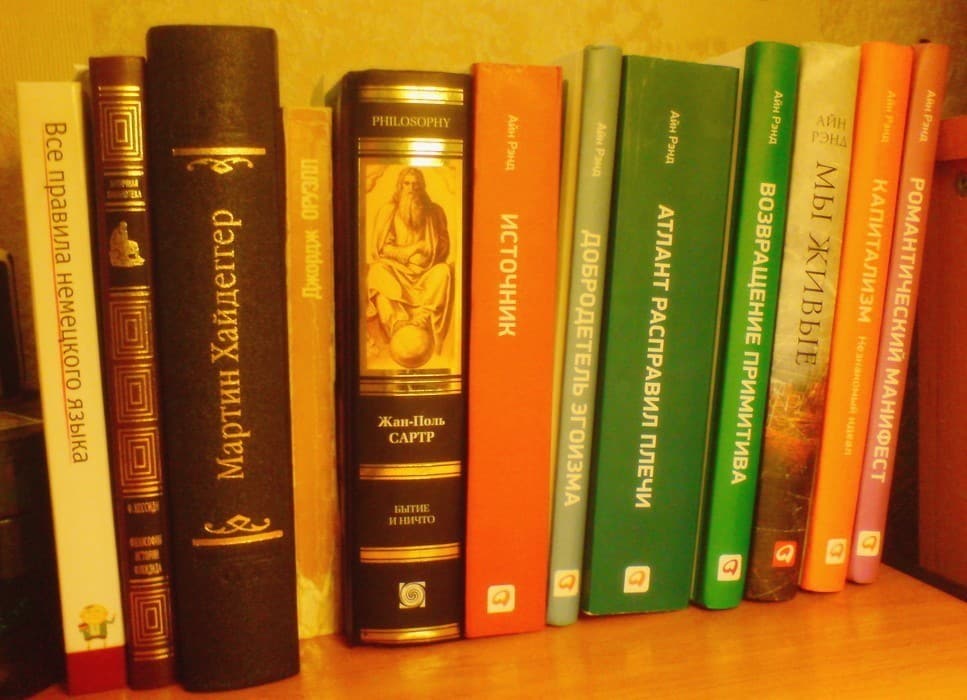
About the spine
At the dawn of book printing, the choice of binding remained with the owner of the book. A person was given a pack of printed sheets, with which he went to his favorite binder and ordered the binding material based on his aesthetic or financial considerations.
It is hard for the modern reader to believe that the spine was originally considered the back side, so all books were placed with the spine against the wall, and pages into the room. Only in the 16th century did the title and the name of the author begin to be stamped on the roots. The text was placed horizontally, and thin books were not signed at all.
Books were constantly getting cheaper in production, so there were a lot of them. So many that without a signed spine it was already hard to find the book you were looking for. So many that the printers themselves began to do the bindings. So many that even thin books have begun to sign the spines.
At this moment, a division arose: according to one tradition, the spine was signed from top to bottom, according to the other – vice versa.
The tradition of placing the inscription on the spine from top to bottom is older, it goes back to a time when there were few books. The reasoning was this: if the book is on the table (or in a small pile), it should be convenient for the reader to read the title.The tradition of signing the spine from bottom to top is newer, it is based on considerations of the convenience of the owner of the bookshelf. It is more convenient to read from bottom to top, because this direction is more consistent with the European tradition of writing from left to right, which is especially noticeable when there are several lines of text on the spine (naturally, the desire to read lines from left to right).
It so happened that in Western Europe and America they began to adhere to an older tradition, and in Eastern Europe – a more modern one.
According to DSTU GOST 7.84: 2008. The information on the spine is printed in sequence from top to bottom. For publications with a block thickness exceeding 40 mm, it is possible to use the transverse arrangement of the information provided.
The first experimental printing house will produce the best quality books for you in the shortest possible time! Call us:
+38 (067) 543 56 55
+38 (099) 543 56 55
+38 (073) 545 56 55Kharkov printing house, printing, offset printing, book printing, magazine printing, catalog printing, notebook printing, poster printing, booklet printing, leaflet printing
Always with you, The first experimental printing house in Kharkov

About the spine
At the dawn of book printing, the choice of binding remained with the owner of the book. A person was given a pack of printed sheets, with which he went to his favorite binder and ordered the binding material based on his aesthetic or financial considerations.
It is hard for the modern reader to believe that the spine was originally considered the back side, so all books were placed with the spine against the wall, and pages into the room. Only in the 16th century did the title and the name of the author begin to be stamped on the roots. The text was placed horizontally, and thin books were not signed at all.
Books were constantly getting cheaper in production, so there were a lot of them. So many that without a signed spine it was already hard to find the book you were looking for. So many that the printers themselves began to do the bindings. So many that even thin books have begun to sign the spines.
At this moment, a division arose: according to one tradition, the spine was signed from top to bottom, according to the other – vice versa.
The tradition of placing the inscription on the spine from top to bottom is older, it goes back to a time when there were few books. The reasoning was this: if the book is on the table (or in a small pile), it should be convenient for the reader to read the title.The tradition of signing the spine from bottom to top is newer, it is based on considerations of the convenience of the owner of the bookshelf. It is more convenient to read from bottom to top, because this direction is more consistent with the European tradition of writing from left to right, which is especially noticeable when there are several lines of text on the spine (naturally, the desire to read lines from left to right).
It so happened that in Western Europe and America they began to adhere to an older tradition, and in Eastern Europe – a more modern one.
According to DSTU GOST 7.84: 2008. The information on the spine is printed in sequence from top to bottom. For publications with a block thickness exceeding 40 mm, it is possible to use the transverse arrangement of the information provided.
The first experimental printing house will produce the best quality books for you in the shortest possible time! Call us:
+38 (067) 543 56 55
+38 (099) 543 56 55
+38 (073) 545 56 55Kharkov printing house, printing, offset printing, book printing, magazine printing, catalog printing, notebook printing, poster printing, booklet printing, leaflet printing
Always with you, The first experimental printing house in Kharkov
 First Model
First Model



